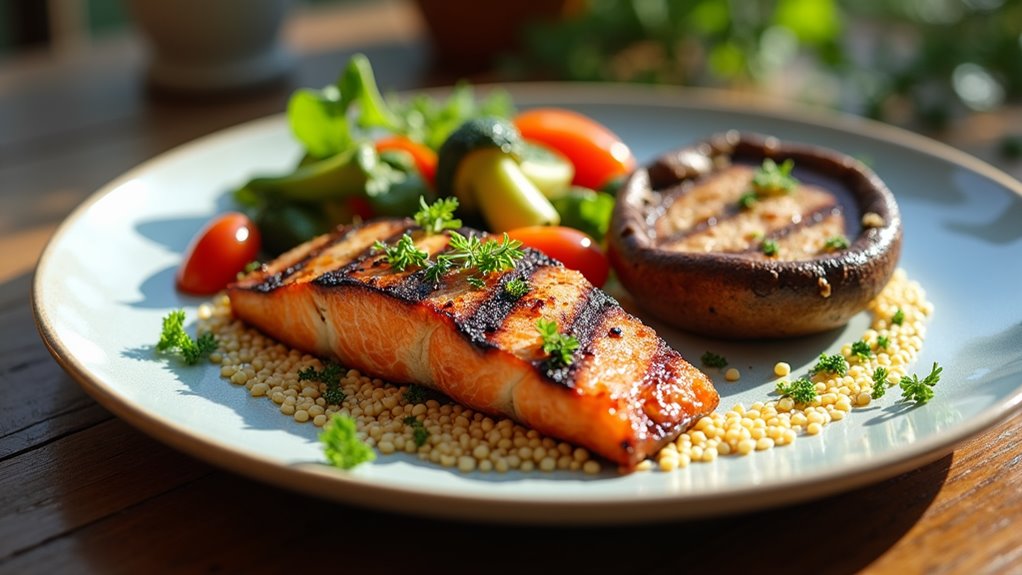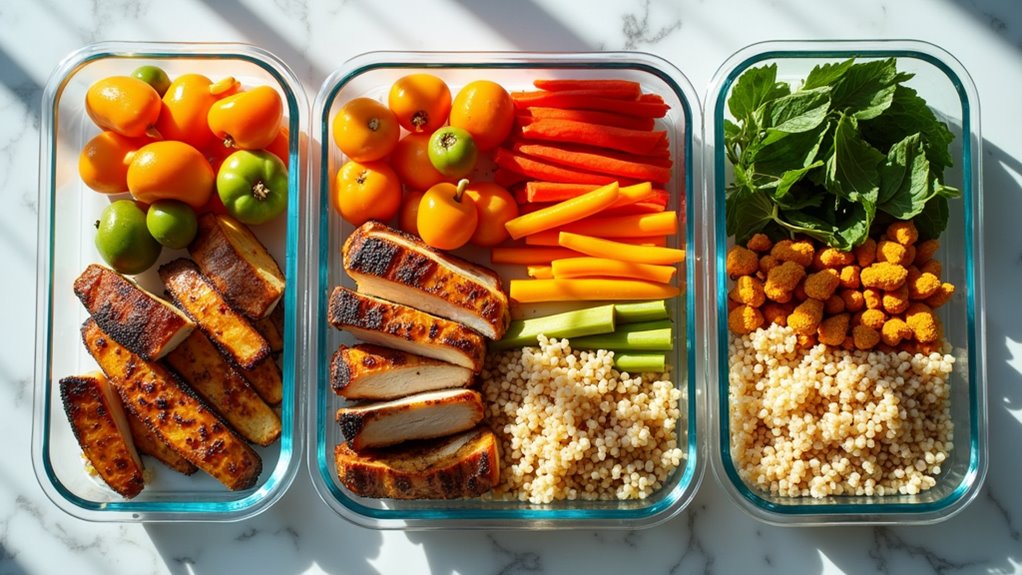You'll find the flexitarian diet offers a practical approach to modern eating by combining plant-based nutrition with occasional meat consumption. As a flexitarian, you can prioritize vegetables, legumes, and whole grains while enjoying meat in moderation – typically 3-4 times per week. This balanced style helps you reduce environmental impact, improve health outcomes, and maintain dietary flexibility without strict rules. You'll shop seasonally, focus on whole foods, and learn smart protein combinations for complete nutrition. By building your plate with colorful vegetables and mindful portions, you're setting yourself up for sustainable, long-term success. The journey toward healthier eating habits becomes an enjoyable exploration of flavors and possibilities.
Key Takeaways
- Balance your plate with 50% vegetables, 25% protein, and 25% whole grains while maintaining flexibility for occasional meat consumption.
- Practice seasonal eating by choosing local, fresh produce to enhance nutrition, reduce costs, and minimize environmental impact.
- Plan 3-4 plant-based meals weekly, incorporating diverse protein sources like legumes and grains for complete nutrition.
- Focus grocery shopping on whole foods around the store's perimeter, emphasizing fresh produce, legumes, and sustainably sourced proteins.
- Navigate social dining by communicating preferences clearly and choosing restaurants with diverse plant-focused menu options.
Understanding the Flexitarian Mindset

While many diets require strict rules and limitations, the flexitarian approach embraces a more balanced philosophy.
As a flexitarian, you'll focus on eating mostly plant-based foods while occasionally including meat, fish, eggs, and dairy. You're not bound by rigid restrictions – instead, you make mindful choices based on your health needs, environmental concerns, and personal preferences.
The flexitarian mindset centers on progress over perfection.
You'll learn to view food choices as flexible options rather than absolute rules. This means you can enjoy a vegetarian meal for breakfast, include chicken at lunch, or opt for a fully plant-based dinner without feeling guilty.
You're empowered to make sustainable dietary changes that fit your lifestyle while contributing to both personal and planetary health.
Benefits of Part-Time Plant Living
The flexitarian mindset naturally leads to meaningful rewards for both you and the planet.
You'll discover reduced grocery bills as you shift away from expensive meat products, while your body benefits from increased fiber intake and lower saturated fat consumption. Research shows that even part-time plant-based eating can help reduce your risk of heart disease, diabetes, and certain cancers.
Your environmental impact shrinks significantly when you choose more plant-based meals.
You'll contribute to reduced greenhouse gas emissions, lower water consumption, and decreased deforestation.
Plus, you'll find yourself exploring new flavors and cooking techniques as you experiment with diverse plant proteins and global cuisines.
The beauty of flexitarian eating lies in its balance – you can enjoy these benefits while maintaining the flexibility to include occasional meat dishes.
Planning Your Weekly Meal Schedule

Successfully adopting flexitarian habits starts with strategic meal planning that balances plant-forward dishes with occasional meat-based meals.
Begin by designating 3-4 days per week as completely plant-based and schedule your preferred meat dishes on remaining days. You'll want to map out your grocery needs in advance, focusing primarily on fresh produce, legumes, and whole grains.
Consider batch-cooking versatile plant proteins like lentils or chickpeas that you can use throughout the week.
Keep your meal plan flexible by choosing recipes that can easily adapt to either plant-based or meat versions. Stock your pantry with meat alternatives such as tofu, tempeh, and seitan to ensure you've got protein-rich options ready.
Remember to prep ingredients ahead of time and store them properly to streamline your daily cooking routine.
Smart Protein Choices
When following a flexitarian diet, you'll benefit from understanding how to alternate effectively between plant and animal proteins.
You can mix protein sources by pairing legumes with whole grains for complete plant-based meals, or by combining smaller portions of meat with generous servings of beans and nuts.
Your weekly menu might include chickpea curry on Monday, a small portion of grilled chicken with quinoa on Tuesday, and lentil pasta with vegetables on Wednesday.
Plant Proteins Vs Meat
Making smart protein choices requires understanding how plant and animal proteins differ in their nutritional profiles and environmental impact. While meat provides complete proteins with all essential amino acids, plant proteins often need combining to achieve the same completeness.
You'll find that lean meats like chicken and fish offer concentrated protein with less environmental impact than red meat.
Plant proteins, including legumes, nuts, and seeds, come with added benefits of fiber, antioxidants, and lower environmental costs. They're typically less expensive and more sustainable than animal proteins.
When you're choosing between plant and animal sources, consider that beans, lentils, and quinoa can provide similar protein content to meat while offering unique nutritional advantages.
Mix and Match Sources
To create balanced meals with optimal nutrition, combining different protein sources offers the best approach. You'll get the most benefit by mixing plant-based proteins like legumes, nuts, and whole grains with moderate portions of lean meats, fish, or eggs.
This strategy ensures you're getting all essential amino acids while maintaining dietary flexibility.
When planning your meals, try pairing quinoa with chicken, or adding chickpeas to your fish dishes. You can also combine black beans with brown rice, or add tofu to your lean beef stir-fry.
These combinations not only enhance the protein content but also provide diverse nutrients like iron, zinc, and B vitamins. You'll find it's easier to meet your nutritional needs when you're not limiting yourself to just one protein category.
Shopping for Flexitarian Success

Success with flexitarian eating starts at the grocery store. You'll want to fill your cart with plenty of fresh produce, legumes, whole grains, and plant-based proteins while leaving room for select meat products.
Keep your shopping focused on the store's perimeter, where you'll find fresh ingredients.
Stock up on versatile staples like quinoa, lentils, and beans that work well as meat alternatives. When you do buy meat, choose quality over quantity – opt for sustainably sourced options and treat them as occasional additions rather than dietary staples.
Don't forget to explore the frozen section for convenient vegetable blends and plant-based proteins.
Creating a flexible shopping list that emphasizes produce and plant proteins while allowing for occasional meat purchases will support your flexitarian lifestyle.
Building a Balanced Plate
You'll find it easier to control portions by using a 9-inch plate and filling half with vegetables, a quarter with lean protein, and a quarter with whole grains.
Including a variety of colorful foods on your plate ensures you're getting different nutrients while making meals visually appealing.
Mix textures by combining crunchy raw vegetables with tender cooked ones, adding seeds or nuts for contrast, and incorporating both smooth and chunky elements to keep meals interesting.
Portion Control Made Simple
Although portion control might seem complicated at first, building a balanced plate on a flexitarian diet is straightforward when you follow a few simple guidelines.
Start by filling half your plate with colorful vegetables and fruits. Reserve one-quarter for whole grains like quinoa, brown rice, or whole wheat pasta. The remaining quarter is for your protein source – whether it's plant-based (beans, lentils, tofu) or occasionally lean meat.
You can use your hand as a portion guide: your palm for protein portions, your closed fist for grains, two open palms for vegetables, and your thumb for healthy fats like avocado or nuts.
Don't forget to listen to your body's hunger cues – they'll help you naturally regulate portion sizes.
Mix Colors and Textures
Creating an appealing flexitarian plate starts with incorporating a vibrant mix of colors and varied textures. You'll want to combine crispy vegetables with creamy legumes, crunchy nuts with tender grains, and smooth avocados with rough quinoa. This contrast makes your meals more satisfying and ensures you're getting diverse nutrients.
Think of your plate as an artist's canvas. Include dark leafy greens, orange sweet potatoes, purple cabbage, red bell peppers, and yellow squash. These colors signal different antioxidants and vitamins.
When you're adding plant-based proteins, consider how they complement your other ingredients. Pair crispy roasted chickpeas with soft roasted vegetables, or top your salads with both smooth hummus and crunchy seeds for an engaging eating experience.
Navigating Social Dining Situations

When following a flexitarian diet, social dining situations can present unique challenges that require thoughtful navigation.
You'll want to communicate your dietary preferences clearly while remaining flexible and adaptable. Before attending social gatherings, let your host know that you primarily eat plant-based foods but occasionally enjoy meat.
At restaurants, scan the menu for vegetarian options that can be modified with protein additions if desired. Don't hesitate to ask your server about ingredient substitutions or plant-based alternatives.
When dining at someone's home, offer to bring a dish that aligns with your eating style – this ensures you'll have something to eat while sharing your approach to flexible eating with others.
Seasonal Eating for Flexitarians
Seasonal eating adds a natural rhythm to the flexitarian lifestyle, building on the adaptable approach needed for social dining.
You'll find that aligning your meals with nature's calendar enhances both nutrition and flavor while reducing environmental impact.
In spring, focus on tender greens, asparagus, and early peas.
Summer brings abundant vegetables like tomatoes, peppers, and zucchini, perfect for light meals with occasional grilled fish.
Fall harvests offer hearty squashes, root vegetables, and wild mushrooms that pair well with both plant-based dishes and lean meats.
Winter calls for preserved foods, hardy greens, and warming soups.
Local farmers' markets are your best resource for discovering what's in season.
You'll notice that seasonal produce typically costs less and tastes better than out-of-season alternatives.
Frequently Asked Questions
How Do I Handle Food Cravings When Transitioning to a Flexitarian Diet?
When you're dealing with food cravings, try gradually reducing your meat portions rather than eliminating them suddenly.
Keep healthy snacks handy, like nuts, fruits, or veggie sticks.
Don't deprive yourself completely – satisfy cravings with smaller portions.
Focus on plant-based alternatives that mimic familiar textures and flavors.
Stay hydrated and plan your meals ahead to avoid impulsive food choices.
Can Children Safely Follow a Flexitarian Eating Pattern?
Children can thrive on a flexitarian diet that's colorful, nourishing, and balanced.
You'll want to ensure they get adequate protein from both plant and animal sources, essential nutrients like B12, iron, and calcium, and healthy fats for brain development.
It's best to consult your pediatrician first, track their growth regularly, and introduce new foods gradually.
Remember that children have different nutritional needs than adults as they grow.
Does Flexitarian Eating Cost More Than a Traditional Diet?
You don't have to spend more on a flexitarian diet – it can actually save you money.
While some plant-based alternatives like mock meats are expensive, focusing on whole foods like beans, lentils, and seasonal vegetables is typically cheaper than buying meat.
You'll also save by reducing your meat portions and choosing less expensive cuts when you do eat meat.
Shop sales and buy in bulk to maximize savings.
What Kitchen Tools Are Essential for Flexitarian Meal Preparation?
Like a well-orchestrated kitchen symphony, you'll need basic tools to create flexible, plant-forward meals.
Start with a high-quality chef's knife and cutting board for vegetable prep. You'll want a food processor for making dips and sauces, a good blender for smoothies, and sturdy mixing bowls.
Don't forget measuring cups, a colander, and microplane grater. A large skillet and Dutch oven complete your essential toolkit.
How Do Supplements Fit Into a Flexitarian Eating Plan?
You'll find that most flexitarian diets provide adequate nutrition through food alone, but supplements can fill specific gaps.
Consider taking vitamin B12 if you're reducing meat intake, and vitamin D if you get limited sun exposure. Omega-3 supplements may help when you're eating less fish.
Always consult your healthcare provider before starting supplements, as they'll assess your individual needs based on your eating patterns.
Conclusion
You're now equipped to embrace the flexitarian lifestyle at your own pace, like a river flowing steadily toward better health. Whether you're enjoying a veggie-packed Buddha bowl on Monday or savoring a small portion of grass-fed beef on Friday, you've learned how to make mindful choices that benefit both your body and the planet. Let this flexible approach become your new normal, one meal at a time.

Leave a Reply